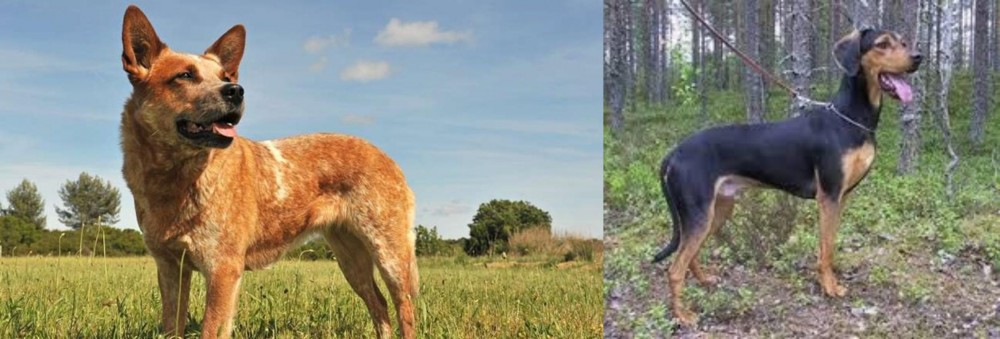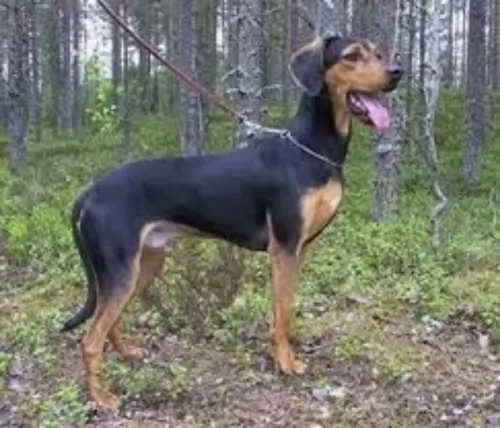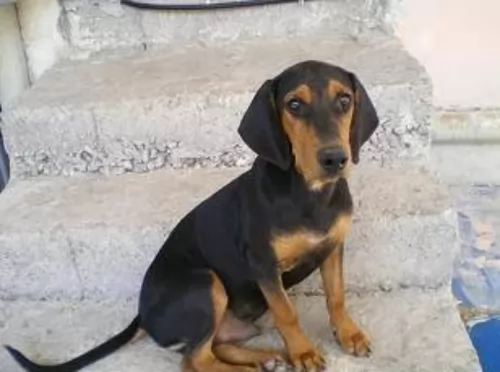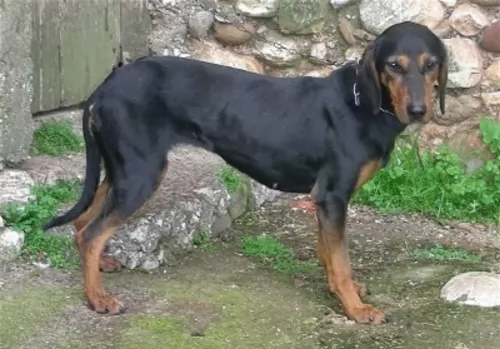 Petzlover
Petzlover Australian Red Heeler is originated from Australia but Greek Harehound is originated from Greece. Both Australian Red Heeler and Greek Harehound are having almost same height. Both Australian Red Heeler and Greek Harehound are having almost same weight. Australian Red Heeler may live 3 years more than Greek Harehound. Both Australian Red Heeler and Greek Harehound has almost same litter size. Australian Red Heeler requires Moderate Maintenance. But Greek Harehound requires Low Maintenance
Australian Red Heeler is originated from Australia but Greek Harehound is originated from Greece. Both Australian Red Heeler and Greek Harehound are having almost same height. Both Australian Red Heeler and Greek Harehound are having almost same weight. Australian Red Heeler may live 3 years more than Greek Harehound. Both Australian Red Heeler and Greek Harehound has almost same litter size. Australian Red Heeler requires Moderate Maintenance. But Greek Harehound requires Low Maintenance
 When George Hall arrived in the New South Wales Colony in 1802 he set about ‘creating’ a tough working- or herding dog. By crossing Australia’s native Dingoes with Collies as well as with other herding dogs, the robust Red Heeler, also known as the Australian Cattle Dog came into being. Today he is a thick-set dog, ideally suited to working livestock.
When George Hall arrived in the New South Wales Colony in 1802 he set about ‘creating’ a tough working- or herding dog. By crossing Australia’s native Dingoes with Collies as well as with other herding dogs, the robust Red Heeler, also known as the Australian Cattle Dog came into being. Today he is a thick-set dog, ideally suited to working livestock.
Ranchers, particularly, were impressed with the breed’s toughness and they were sought after on cattle stations. The name actually comes from them when the dogs are herding animals, they nip at their heels to get them moving.
The Blue Heeler and the Red Heeler breed are the exact same dog, but just different colors. These Australian cattle dogs originated in Australia in the mid-1800s and adapted well to the harsh desert environment of the outback.
 Known also as the Hellenic Hound, the Greek Harehound is an ancient breed, and it is a dog which has come down through the ages with very little change to the way he looks.
Known also as the Hellenic Hound, the Greek Harehound is an ancient breed, and it is a dog which has come down through the ages with very little change to the way he looks.
The ancestors of the Greek Harehound go back thousands of years and are believed to be the ancient ‘Laconikoi’ dogs of the Peloponnese.
In was in 1996 that the Federation Cynologique Internationale recognized the Hellenic Hound. The Greek Harehound was also recognized by the United Kennel Club (UKC) in 2006.
 The Red Heeler or Australian Cattle Dog is a sturdy, muscular dog with ears that are pricked and with dark, alert eyes. The tail is long. The neck, shoulders and legs of the Red Heeler are strong and muscular. The dog is longer than tall – the length of the body is greater than the height at the withers. A well fed, well exercised, well cared for Red Heeler will weight roughly 15–22 kilograms.
The Red Heeler or Australian Cattle Dog is a sturdy, muscular dog with ears that are pricked and with dark, alert eyes. The tail is long. The neck, shoulders and legs of the Red Heeler are strong and muscular. The dog is longer than tall – the length of the body is greater than the height at the withers. A well fed, well exercised, well cared for Red Heeler will weight roughly 15–22 kilograms.
There are 2 coat colours of the Reeler – red and blue, but there are are lesser varieties such as chocolate, cream, blue mottled, brindle and some with white markings. It is interesting to note that with both the Red- and the Blue Heeler, puppies are generally born white, with the coat turning to red as they mature.
These Australian Cattle Dogs display patches of solid colour, and you might well find masks over one or both eyes and a white tip to the tail. Both the Red and Blue Heeler can have a white star on the forehead which is referred to as the Bentley Mark. The Heelers have a double coat - short, straight outer hairs while the undercoat is short, fine and dense. Despite their short coat, they shed a lot.
 These dogs have a short, dense coat which is black and tan in color. He is a medium sized, well proportioned, deep chested dog standing at roughly 47 – 55cm in height and weighing between 17–20kg.
These dogs have a short, dense coat which is black and tan in color. He is a medium sized, well proportioned, deep chested dog standing at roughly 47 – 55cm in height and weighing between 17–20kg.
His legs are straight, well boned and strong. The skull of the dog is fairly flat, the eyes are brown while the ears are set high and are floppy. The tail is long, tapering down to a tip.
Lively and outgoing, the Greek Harehound is a skilled, brave hunter. These are active dogs and will require quite a bit of exercise if you get one as a pet. He becomes devoted to his owner, making a good, all-round family pet.
He has always been used in the past to hunt in packs so he gets on well with any other dogs in the family.
As a scenthound, the Greek Harehound is an independent, stubborn, strong-willed dog that will respond well to a firm, strong owner. His stubborn, strong-willed nature means it will be important to have him trained and socialized so that he becomes a well-rounded, obedient pet.
If you're looking for a true around-the-house family pet, this isn't the ideal choice as he is essentially a hunting dog, wanting to be running off on a hunt as opposed to lying quietly indoors. He is therefore better suited to life in the country than being cooped up in a small city property.
 Your Australian Red Heeler needs plenty of exercise but also plenty of companionship too from his human family. He is an affectionate, playful pet but is reserved with people he doesn’t know. When socialized he is patient with children in the home but he does still have the tendency to herd them and nip at their heels. The dog builds up a strong bond with his human family, and is protective toward them, being happy to be close to his owner’s side.
Your Australian Red Heeler needs plenty of exercise but also plenty of companionship too from his human family. He is an affectionate, playful pet but is reserved with people he doesn’t know. When socialized he is patient with children in the home but he does still have the tendency to herd them and nip at their heels. The dog builds up a strong bond with his human family, and is protective toward them, being happy to be close to his owner’s side.
Red Heelers need activities and lots of room to play, and they therefore won’t adapt to apartment living. If you don’t live on a farm, don’t neglect your working dog as he will need lots of rough and tumble games and activities to keep him from boredom. Treat your Australian Red Heeler with the love, patience and kindness and you’ll bring out the very best from this active, loyal fur-friend of yours.
 Fast, courageous, smart, playful, independent and strong willed, the Greek Harehound is a slow maturing breed and he will require training and socialization to make him obedient and not so stubborn.
Fast, courageous, smart, playful, independent and strong willed, the Greek Harehound is a slow maturing breed and he will require training and socialization to make him obedient and not so stubborn.
Once trained he becomes a truly wonderful companion, being affectionate, loyal and outgoing. He makes a good friend of children too.
He is friendly and non-aggressive, though he still makes a good watchdog. He is a low maintenance pet too, and even though he is essentially a hunting dog, he can make anyone a splendid pet.
 The Australian Cattle Dog is quite often affected by progressive retinal atrophy, an eye condition where the rods and cones in the retina of the eye deteriorate later in life, and it could lead to blindness. This eye illness is an autosomal recessive trait, and even if the dog doesn’t develop the condition himself, he can be a carrier of the affected gene.
The Australian Cattle Dog is quite often affected by progressive retinal atrophy, an eye condition where the rods and cones in the retina of the eye deteriorate later in life, and it could lead to blindness. This eye illness is an autosomal recessive trait, and even if the dog doesn’t develop the condition himself, he can be a carrier of the affected gene.
The Heeler is just bursting with personality and energy and a study of dogs diagnosed at veterinary colleges described fractures and ligament tears as one of the most common conditions treated with the Australian Red Heeler.
You love your Australian Red Heeler and you want to take good care of him. Check with your vet because at 8 weeks he should be starting with his first puppy vaccinations.
To keep your best friend healthy and happy, watch his diet, ensure he gets plenty of exercise, brush his teeth regularly to remove plaque build-up, and always call your veterinarian when you see he is ill and isn’t his usual boisterous self.
 The Greek Harehound is a healthy dog breed with no particular genetic defects. But like other dogs with floppy ears, they are more prone to infections and the insides of the ears will need to be cleaned frequently. Always do this with the utmost care to avoid damaging your pet's ears.
The Greek Harehound is a healthy dog breed with no particular genetic defects. But like other dogs with floppy ears, they are more prone to infections and the insides of the ears will need to be cleaned frequently. Always do this with the utmost care to avoid damaging your pet's ears.
He is a deep chested dog and this puts him at risk of gastric dilation and volvulus which is commonly referred to as bloat. Its a life threatening health issue where the stomach can twist. The stomach is sealed off as a result and gas builds up. The dog can go into organ failure.
 The Australian Red Heeler is a low maintenance dog. He does shed quite a bit so you’ll need to brush his coat at least twice a week to remove loose hairs and to keep his coat lustrous. When your dog has been in a particularly dusty area, you you wipe his coat down with a damp cloth. As with all dogs, you’ll want to check his teeth, ears, eyes and nails regularly to avoid health problems.
The Australian Red Heeler is a low maintenance dog. He does shed quite a bit so you’ll need to brush his coat at least twice a week to remove loose hairs and to keep his coat lustrous. When your dog has been in a particularly dusty area, you you wipe his coat down with a damp cloth. As with all dogs, you’ll want to check his teeth, ears, eyes and nails regularly to avoid health problems.
If you care for your working- and herding dog you’ll train him to that he becomes a good family dog and companion. The Red Heeler has plenty of energy and stamina and if he grows up untrained and un-socialized, you could see him becoming aggressive towards other animals and even your own children. He certainly becomes over-protective of his territory if not socialized. Train him as he is an intelligent breed and responds well to training.
Any vet will tell you of the critical importance of a proper diet and exercise routine for your dog. He’s an active, smart dog with loads of energy and you want to keep his diet consistent with this energy. Speak to your vet about what food would suit your pet best, because a high quality diet appropriate to his age, his body size and his energy levels will be important. Along with high quality foods which include a good intake of raw meat, your dog must always have access to a bowl of fresh, cool water.
 The Greek Harehound is happiest when he senses he is free to follow scents and run. This is why this particular dog breed isn’t suited for life in the city where he has a small garden. He requires large pieces of ground to run free. If you own one of these dogs, he should be taken on daily walks and be involved in lots of sporting activities and games. If you’re a jogger or cyclist, this dog will be thrilled to join you.
The Greek Harehound is happiest when he senses he is free to follow scents and run. This is why this particular dog breed isn’t suited for life in the city where he has a small garden. He requires large pieces of ground to run free. If you own one of these dogs, he should be taken on daily walks and be involved in lots of sporting activities and games. If you’re a jogger or cyclist, this dog will be thrilled to join you.
Dog owners love that this dog is a low maintenance breed. The short coat simply requires a brush twice a week to rid him of loose hairs and to also keep his coat shiny and healthy.
Every new puppy will require a series of vaccinations in his first year to make sure he doesn't develop some of the serious dog diseases there are such as distemper, parvo-virus and rabies among others.
Dogs are carnivores and without human interference have always eaten fresh meat in the wilds. For convenience many people feed their dogs commercially manufactured food.
There are some excellent brands. Choose the best one for your pet and mix in raw meat from time to time as well as cooked rice, chicken and vegetables.
Never leave your pet without a constant supply of fresh, cool water.